In 1933, with nearly a quarter of the civilian labor force unemployed, newly inaugurated President Franklin Delano Roosevelt initiated the Civilian Conservation Corps (CCC), a cornerstone effort in his New Deal program.
Under the direction of several governmental departments, including the Department of Labor, Agriculture, War, and Interior, the CCC recruited men from across the country to work in nature preservation and the creation of federal parks. While all the CCC camps where recruits lived operated under a military authority with army officers in command, regional styles dictated daily camp life, including segregated camps in the American South. By the program’s disbanding in 1942, nearly 4,000 camps across the United States had employed over three million Americans.
In Wisconsin, the CCC established much of the Chequamegon-Nicolet National Forest, Devil’s Lake State Park, and Wyalusing State Park, as well as a number of smaller parks. In northern Wisconsin, much of the CCC’s work focused on reestablishing the forests that had been clear-cut by the logging industry in the late nineteenth and early twentieth century.
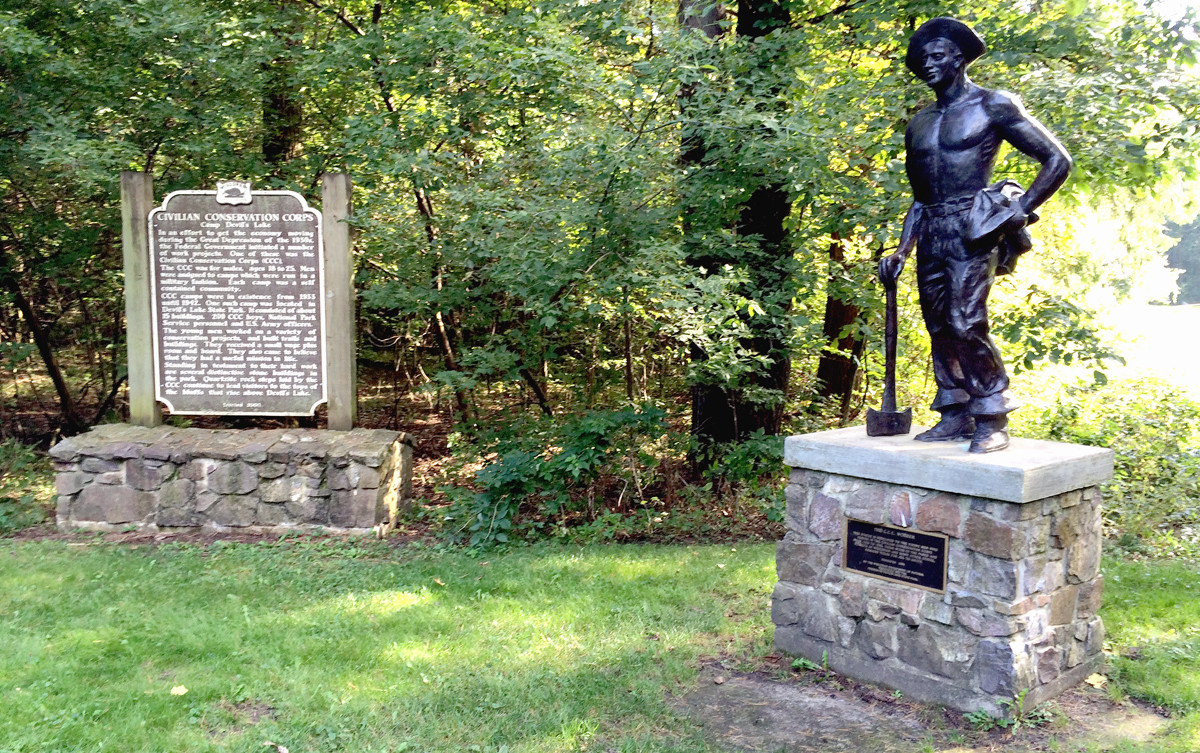
Throughout its existence in Wisconsin, the Corps employed over 92,000 young men (75,000 of whom were Wisconsinites) and paid out about $16.5 million dollars to enrollee dependents.
Camp 657, originally established in Fort Sheridan, Illinois, was in existence for almost the entire life span of the CCC program. The work to reestablish the camp in Wisconsin began in June 1933 with the arrival of 220 enrollees and officers at a site three miles west of Summit Lake in Langlade County. By late fall, the camp moved once again to Otter Lake in Elcho, marching in military formation from their tents at Summit Lake to the more permanent barracks in Elcho.
Camp 657 served as headquarters for several operations in the northern Wisconsin region and operated a satellite camp at the Antigo County Fairgrounds.
In its first four years of operation, enrollees at Camp 657 worked at a feverish pace to construct a number of infrastructure projects in the county, including building and installing 83 miles of truck trails, 12 miles of fire breaks, 23 miles of vehicular bridges, 235 miles of telephone lines, 15 toolboxes, 4 lookout towers, and 2 lookout cabins for forest fire control and firefighting. Members of Camp 657 also planted 1,379 acres of trees and improved 485 acres of forestland and were responsible for creating three acres of campgrounds, stocking streams and ponds with fish, and improved conditions for wild game.
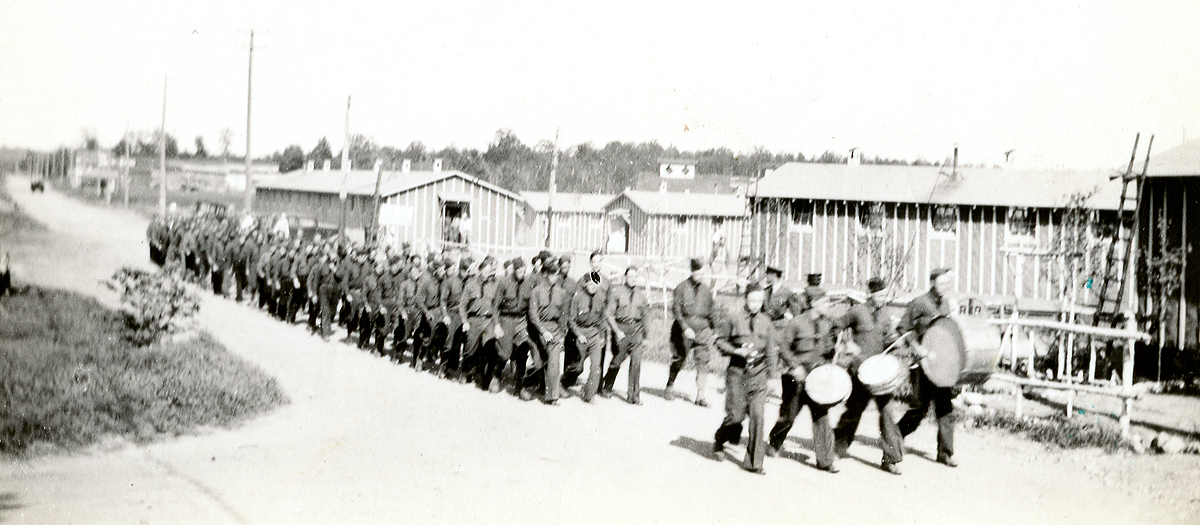
By the early 1940s, with national economic conditions improving across most industries, the CCC began the gradual process of winding down its work. In 1940, Wisconsin had only twelve camps in operation, including Camp 657 in Elcho. Just one year later, with the United States’ entrance into World War II, the CCC ceased operations across the country. More than eighty years after the closing of the last CCC camp, however, hundreds of thousands of Wisconsinites still enjoy the work completed by the enrollees of the CCC camps across the state.
Written by Joe Hermolin, October 2015.
SOURCES
Carol Ahlgren, “The Civilian Conservation Corps and Wisconsin State Park Development,” Wisconsin Magazine of History 71, 3 (1988): 184-204
Perry H. Merril, Roosevelt’s Forest Army: A History of the Civilian Conservation Corps, 1933-1942 (Montpelier, VT: P.H. Merrill, 1981).
Work is Begun at Forest Camp,” Antigo Daily Journal, June 23, 1933.
“Company Moves into Barracks: Civilian Conservation Corps Men Moved from Summit Lake to Elcho,” Antigo Daily Journal, November 27, 1933.
Presentation by William Wolff Jr., President of the Wisconsin chapter to the National Association of CCC Alumni to the Langlade County Historical Society annual meeting, as reported in Antigo Daily Journal, September 27, 1984.
Civilian Conservation Corps, US Sparta District, Wisconsin, “657th Company S-91, Elcho, Wisconsin,” in Sparta CCC District: Sixth Corps Area, by Civilian Conservation Corps, US Sparta District, Wisconsin (Baton Rouge, LA: Direct Advertising Co., 1937), 78-80. Also available digitally at http://content.wisconsinhistory.org/cdm/ref/collection/tp/id/28084.
Featured image: Civilian Conservation Corps recruits in line for the mess hall at Camp 657’s temporary location near Summit Lake, Wisconsin, c. 1933. Photograph courtesy of the Langlade County Historical Society.
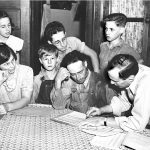
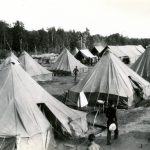

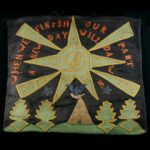
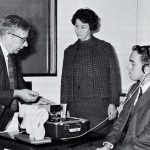
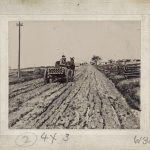
I’m looking for two men that were in the CCC in Wisconsin, but I don’t know where. I found a picture of my uncle William Oranger, but now I can’t find it. My father-in-law was also in the CCC Camp, but I don’t know where in Wisconsin. His name was Walter Thomas Williams. Is there any way I can find where they were? Pictures? Anything?
I was able to find a digitized copy of the Sparta CCC District, Sixth Corp Area Annual publication from 1937. In this document there was a William Oranger listed amongst the members of the 626th Company S-53 stationed in Danbury, Wisconsin. I don’t know when William was active, but some of the projects the company completed between 1933 and 1937 included: clearing approximately 1,500 acres of debris caused by a forest fire and planting 400 acres of Jack and Norway pine, logging over 100,000 board feet of Norway and White pine, building approximately 73 miles of truck roads for the Forest Service in Burnett County, and constructing a 130-foot bridge over the St. Croix River (which was located about half way between County Trunk-T Bridge in Douglas County and the Riverside Bridge on Highway 35.)
From my quick search, I wasn’t able to find anything on Walter T. Williams, but he’s a bit tricker to search for because it’s a much more common name. The Wisconsin State Historical Society has many resources on the CCC in Wisconsin, and you might find what you’re looking for by talking to an archivist there. There’s also a collection of CCC Records at UW-River Falls, and perhaps a librarian there would be able to help. You also always have the option of contacting the National Archives who would be able to look up the company your father-in-law was enlisted in. It’s much easier to find photographs and information once you know the company and/or camp.
Happy researching!